Note: All new content is published at my new website, AaronNewcomer.com. This site will remain around until everything is transfered there.
Please visit AaronNewcomer.com to see lots of new articles on pinfire guns, Pauly guns, rare gun-related journals and books, unique cartridges and more!
Pinfires & the Civil War: A Timeline
← Go Back to read more ArticlesTowards the beginning of the war the United States Ordnance Department imported nearly 13,000 Lefaucheux pinfire revolvers. The United States had been working for nearly a decade before the war to modernize its aging weapons and technology and received many favorable reports of European armies adopting the pinfire system. In 1857 and 1858 a couple of tests were done by the Ordnance Department on a few calibers of pinfire revolvers all of which received very favorable reviews.
September 28, 1861 marked the entrance of pinfire arms in the Civil War. On this date the US Government bought 52 Lefaucheux revolvers and ammunition from a New York gun dealer, Hermann Boker & Co. A month later Colonel Schuyler purchased 10,000 Lefaucheux Model 1854 revolvers directly from Eugene Lefaucheux in France. The rest of the revolvers were acquired by small purchases from various military suppliers.
Schuyler bought back 200,000 rounds of ammunition with his large purchase of revolvers but 20 cartridges per gun was clearly not going to be enough to make this a useful weapon in the war. So at the beginning of January 1862 Lieutenant Treadwell of the Frankford Arsenal met with Christian Sharps to talk about manufacturing pinfire cartridges to a more powerful specification, and then he gave Sharps an order for cartridges on January 6.

Christian Sharps' Cartridges
On January 7th, C. Sharps & Company accepted the order and its terms. They were supposed to have delivered 50,000 cartridges by first of February, 200,000 by end of February, and 400,000 per month after until they reached 1,000,000 cartridges delivered.
By February 20th Treadwell had still not received anything from Christian Sharps so Captain Crispin, Treadwells's boss, went to General Ripley seeking guidance on what to do about the situation. Ripley gave Crispin the OK to buy 200,000 cartridges with the higher powder quantity "equal to those of Colts army revolvers" from a different manufacturer.
Meanwhile, near the end of January, Schuyler, Hartley & Graham had contacted Crispin with an offer to provide pinfire cartridges. This offer went unanswered until a month later when Crispin was given permission to seek another manufacturer.
Now obviously the firm of Schuyler, Hartley & Graham was not a manufacturer; they had contracted with C. D. Leet to make the cartridges. So on February 28th, after Ripley's letter to Crispin, Crispin contacted C. D. Leet directly to order 250,000 pinfire cartridges.

Letter and receipt for pinfire cartridges furnished by C.D. Leet.
March 20 brings the first correspondence from Christian Sharps since the initial order for pinfire cartridges. In his letter to Major Laidley, the new commander of the Frankford Arsenal, He said that they were still working on the process of making the cartridges, and were having a hard time with it, and that they also needed to move to a new location because of Philadelphia laws not allowing them to have more than 25lbs of powder on their premises.
This news causes Major Laidley to seek out another vendor to provide pinfire cartridges. He ends up contracting with W. P. Wilstach on March 25th to furnish 1,000,000 cartridges. W. P. Wilstach was in the saddlery and hardware business, and did not actually make cartridges so they subcontracted their pinfire cartridge order to Allen & Wheelock of Worcester, Massachusetts.
On April 4th Christian Sharps finally delivers some test samples, of which Laidley was disgusted with and denied in a pretty strong letter back to Sharps, calling them a "failure" and of "no value to the United States."
April 14th brings the very first delivery of US made pinfire cartridges. On this day C. D. Leet delivered their first lot of 50,000 cartridges. The letter pictured is dated April 26 and is from C. D. Leet to the Ordinance Department requesting paid for the first delivery. The Ordinance Department approved the payment on April 30th. I believe that the box variation on the bottom right in the following picture are the boxes that were used for the whole first and maybe second order. The other two I believe were produced for the final C. D. Leet order mentioned below.

C. D. Leet Pinfire Boxes with C. D. Leet Pinfire Cartridges
W. P. Wilstach missed their first delivery due on April 24th.
C. D. Leet delivers 2nd batch of 88,000 in the very beginning of May.
May 3rd Crispin orders 200,000 more from C. D. Leet.
May 10th, Laidley rejects a second group of test samples from Sharps & Hankins because their cartridges were unsatisfactory, they use poor quality powder, and way too many failures.
May 16 C. D. Leet delivers last of first order.
May 31 W. P. Wilstach delivered 202,800 cartridges which had lots of failures and was generally unsatisfactory.

W. P. Wilstach Pinfire Box
June 7th Christian Sharps finally delivers 46,000 that were accepted. This is all that ended up being accepted by them.
June 30 and July 31st W. P. Wilstach delivered the rest of their 1,000,000 cartridges which had no complaints.
June 22 is when we find out that Allen & Wheelock was the manufacturer who W. P. Wilstach subcontracted with. Allen & Wheelock contacts Ripley, stating they just supplied 1,000,000 cartridges and would like to supply the government direct. The government however did not require any more from them.
The final order of pinfire cartridges was Dec 10, 1863 for 76,000 from C. D. Leet.
So I believe this clearly lays out that 3 distinct parties made pinfire cartridges in the United States separate from each other for the Civil War.
Allen & Wheelock made the most at 1,000,000
C. D. Leet made 526,000
And Sharps made 46,000
After the war Allen & Wheelock then made the same cartridge under both the Allen & Wheelock name as well as slightly later under the Ethan Allen name, so who knows how many more they made. C. D. Leet sold their business to Schuyler, Hartley & Graham, who later made the common UMC pinfires. I think that early Union Metallic Cartridge & Cap Co., before becoming UMC may have even used C. D. Leets dies and design to sell pinfires, as their catalog has pictures that look a lot more like C. D. Leets than the pictures of the short 12mm pinfire in later UMC catalogs. They also could have just bought surplus cartridges left from the war.
References and Further Research:
Thomas, Dean. Round Ball to Rimfire Part Three. Gettyburg, PA: Thomas Publications, 2003.
Curtis, Chris C.. Systeme Lefaucheux: Continuing the Study of Pinfire Cartridge Arms Including Their Role in the American Civil War. Santa Ana, CA: Armslore Press, 2002.
Behling, Louis. "Christian Sharps' Cartridges image".
National Archives. "C. D. Leet Letter" contains original hand written document by C. D. Leet. Paper background modified for aesthetics.
Article last updated: March 27, 2012 5:50 PM
